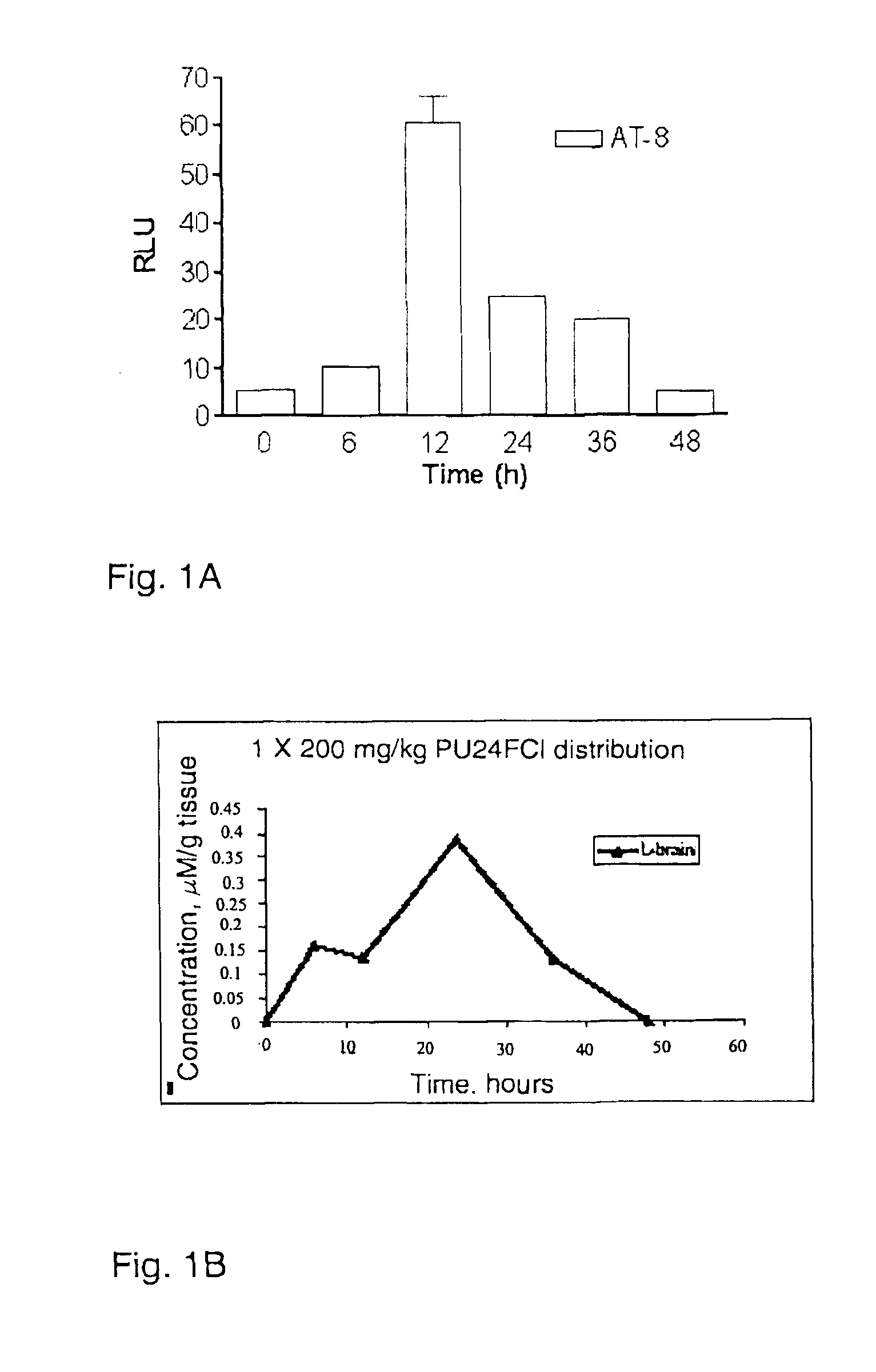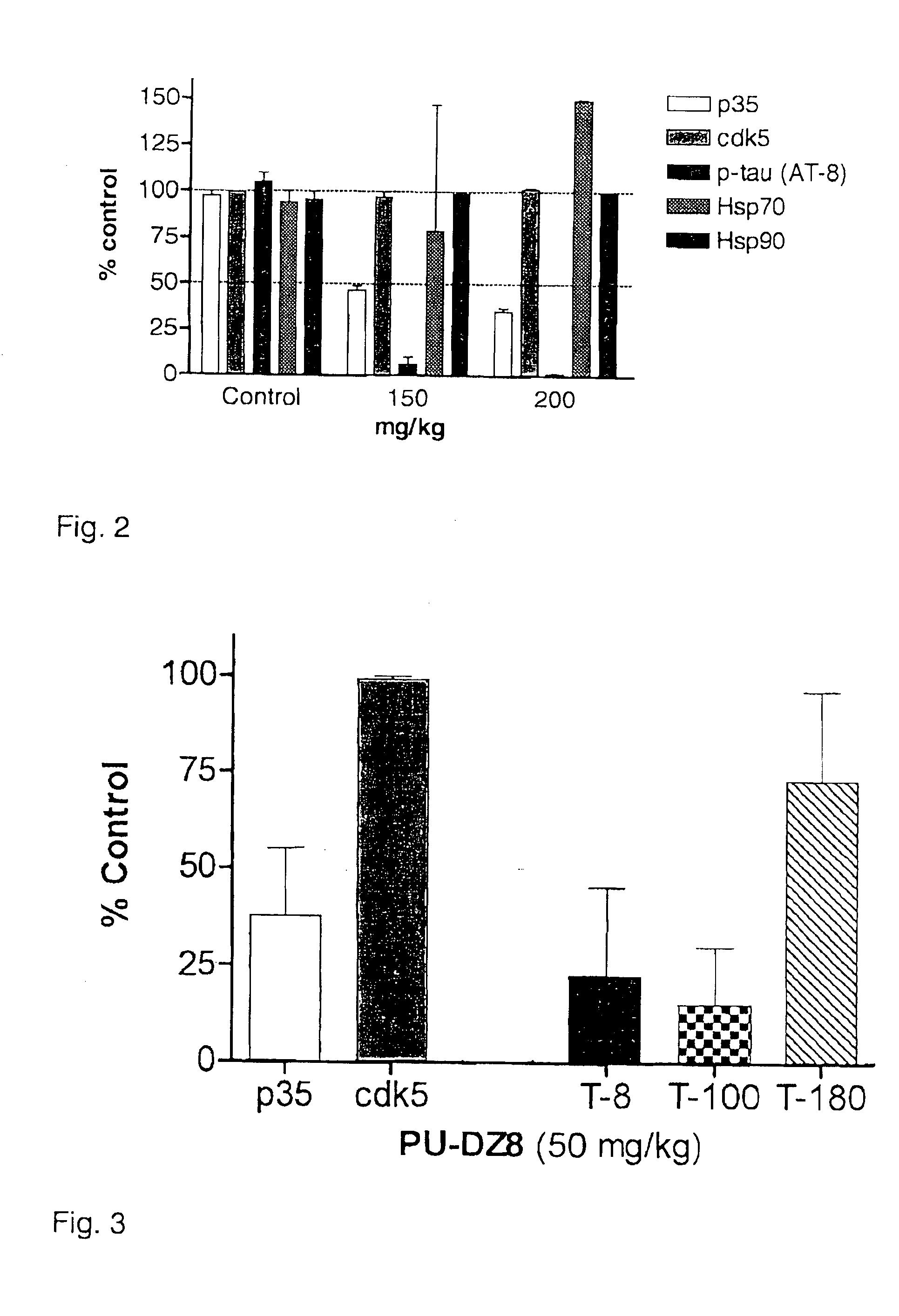Treatment of Neurodegenerative Diseases Through Inhibition of HSP90
a technology of heat shock protein and neurodegenerative diseases, applied in the direction of biocide, anti-noxious agents, drug compositions, etc., can solve the problems of significant reduction in the robustness of cellular networks, unbalanced chaperone requirement and chaperone capacity, and aggregate reduction and subsequent plaque or tangle formation
- Summary
- Abstract
- Description
- Claims
- Application Information
AI Technical Summary
Benefits of technology
Problems solved by technology
Method used
Image
Examples
example 1
[0074]Juvenile mice: Four-to six-week old nu / nu athymic female mice were obtained from the National Cancer Institute-Frederick Cancer Center and maintained in ventilated caging. Experiments were earned out under an Institutional Animal Care and Use Committee-approved protocol, and institutional guidelines for the proper and humane use of animals in research were followed. Before administration, a solution of PU24FC1 was prepared at desired concentration in 50 μL vehicle (PBS:DMSO:EtOH at 1:1:1 ratio). In experiments designed to define the short-term effects of PU24FC1 on tau phosphorylation, mice (2 per time point) were treated with 200 mg / kg PU24FC1 or with vehicle alone. At the time of sacrifice, brains were collected and immediately flash frozen. For protein analysis brains were homogenized in SDS lysis buffer (50 mM Tris pH 7.4, 2% SDS). For long-term administration studies, mice (n=5) were treated every other day for 30 days with the indicated doses of PU24FC1. Weight and behav...
example 2
[0078]Transgenic mice: Transgenic mice, JNPL3 line (59) overexpressing mutant human tau (P301L, 4R0N) were used in this study. Mice were heterozygous and on a mixed hybrid genetic background composed of C57BL / DBA2 / SW, as published in ref. 59. These mice develop NFTs in the basal telencephalon, diencephalon, brainstem, and spinal cord, with severe pathology accompanied by degeneration in the spinal cord leading to dystonia, paralysis, and death in mice >12 months in age. Nine month-old male JNPL3 mice (n=2) were treated intraperitoneally with PU-DZ8 or vehicle for 5 days. Mice were sacrificed 12 h after last treatment by cervical dislocation under anesthesia.
[0079]To further examine the effect of Hsp90 on tau phosphorylation, we used the JNPL3 line of mice expressing mutant (P301L) tau protein (59). Genetic analyses have linked mutations in the tau gene to FTDP-17 (60, 61). Over 20 distinct pathogenic mutations have been identified, with P301L as the most common mutation in tauophati...
example 3
[0081]JNPL3 female mice 6.5 months of age were treated for 30 days, 5 day / week, with the Hsp90 inhibitor PU-DZ8 (FIG. 5) or vehicle, or sacrificed for time zero, n=4 / group. Brains were divided in subcortical and cortical regions and processed using the Greenberg and Davies extraction protocol. (77) Sarkosyl soluble fractions (S1) were analyzed by WB for p35 and Hsp70, and for tau epitopes found abnormally hyperphosphorylated in AD brains such as: S202 and T205 recognized by AT8,T181 by AT270, T231 by AT180. These are putative cdk5 / p35 sites. Protein bands were normalized to Hsp90 and plotted as relative units. The results are shown in FIG. 8A and B. Since tauopathy, characterized by pathogenic phosphorylation of tau can be due to aberrant kinase activity, the hsp90 inhibitor is effective because it affects the expression of the p35 protein, an activator of cdk5 known to phosphorylate tau at pathogenic sites, and thus alleviates tau phosphorylation at these sites.
PUM
| Property | Measurement | Unit |
|---|---|---|
| molecular weights | aaaaa | aaaaa |
| LogP | aaaaa | aaaaa |
| logP | aaaaa | aaaaa |
Abstract
Description
Claims
Application Information
 Login to View More
Login to View More - R&D
- Intellectual Property
- Life Sciences
- Materials
- Tech Scout
- Unparalleled Data Quality
- Higher Quality Content
- 60% Fewer Hallucinations
Browse by: Latest US Patents, China's latest patents, Technical Efficacy Thesaurus, Application Domain, Technology Topic, Popular Technical Reports.
© 2025 PatSnap. All rights reserved.Legal|Privacy policy|Modern Slavery Act Transparency Statement|Sitemap|About US| Contact US: help@patsnap.com



